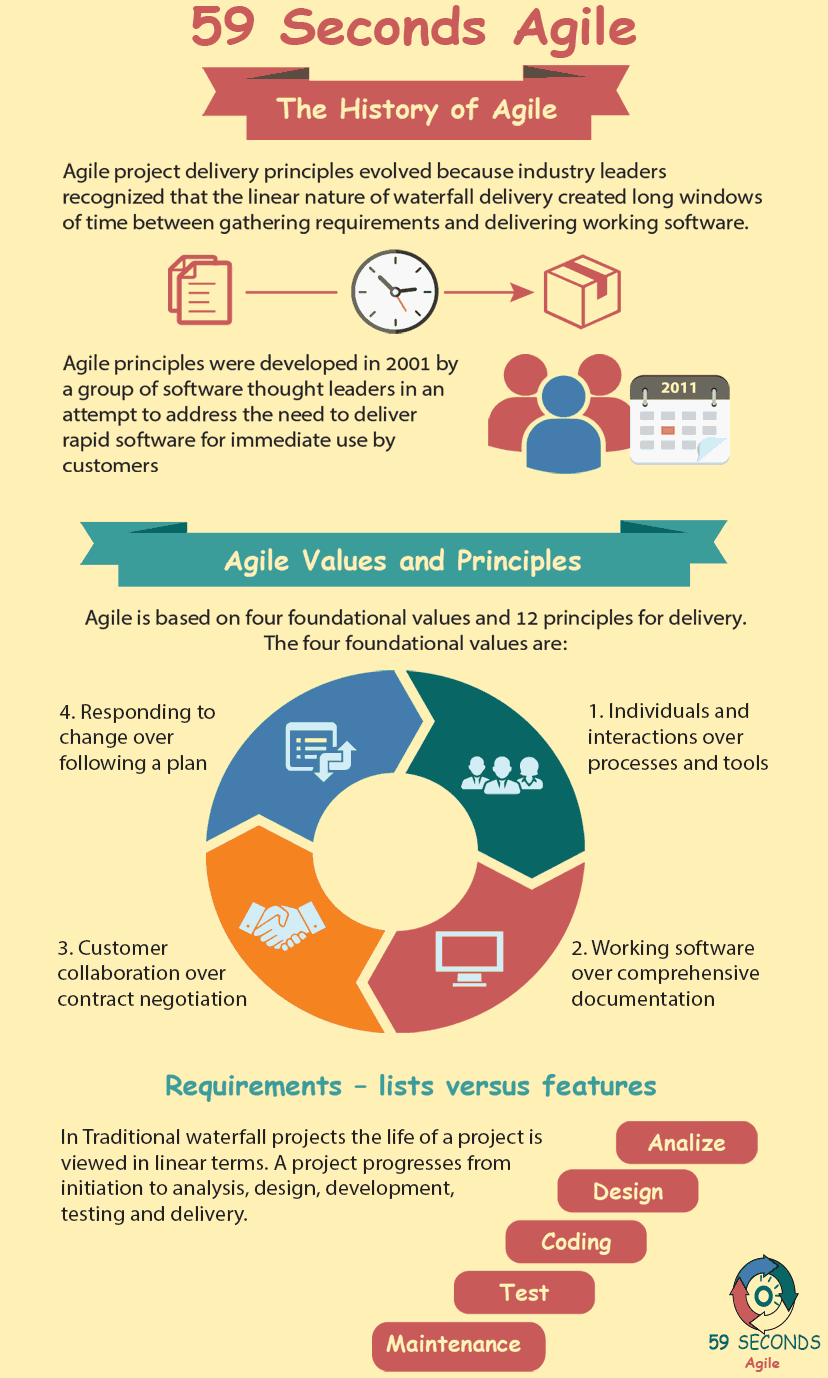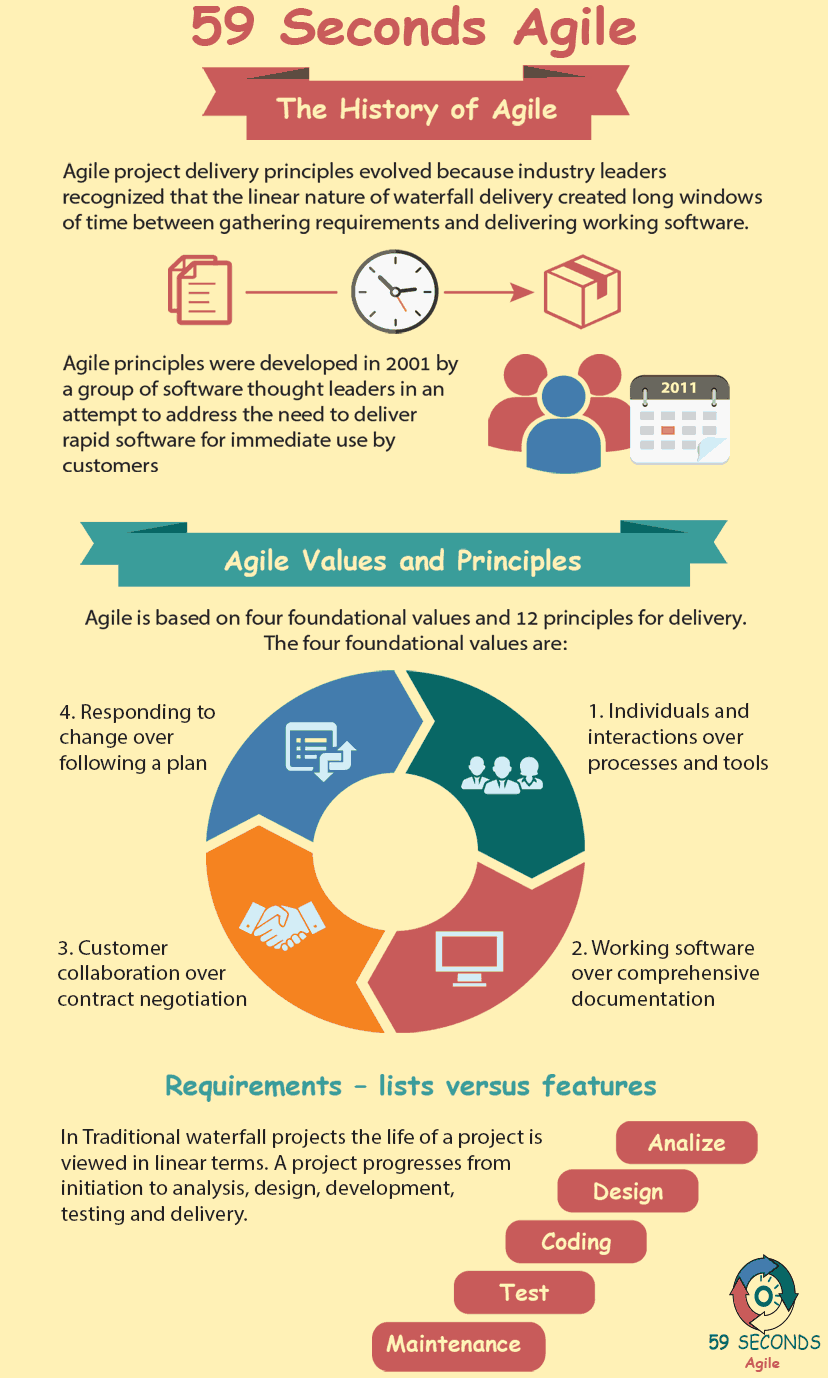This article covers what is a Scrum Product Owner and discussed what role the Product Owner plays within an Agile Project. This article starts with an introduction into the background of Agile and the Agile Values and Agile Principles.
The History of Agile
A 59 Seconds Agile Video Animation
The History Of Agile For The Product Owner
Product owners are central to the successful transformation of companies using the Agile values and principles. The product owner role evolved from the traditional business analyst with notable differences. The same analytical skills are required for both roles with a strong product owner being an entrepreneur who views features as assets with a high value in the organization.
Agile project delivery principles evolved because industry leaders recognized that the linear nature of traditional delivery created long windows of time between gathering requirements and delivering working software. Long delivery cycles were ineffective since market changes and product vision updates could not be accounted for without losing time and productivity. The traditional project delivery approaches are not designed to account for immediate changes in scope or features.
Agile principles were developed in 2001 by a group of software thought leaders in an attempt to address the need to deliver rapid software for immediate use by customers. These thought leaders believed that change should be embraced. Agile was developed to deliver features in smaller, working increments to the customer.
Scrum Product Owner: Agile Values and Principles
Agile is based on four foundational values and 12 principles for delivery. The four foundational values are:
Valuing individuals and interaction over processes and tools,
Delivering working software versus voluminous documentation,
Collaborating with customers versus intense contract negotiations and
Immediately responding to change versus strict adherence to the original plan.

The Scrum Product Owner Role
The Scrum Product Owner as the voice of the customer is responsible for taking the vision of an organization and delivering well-defined features. The foundational values are reflected in the thoughtfulness of delivery that a product owner provides. Features need to be more than well-written stories. Features should also evolve over the life of a project. As Agile evolves in an organization the role of the product owner also evolves to move from the traditional business analyst with strong analytical skills to a leader who views product ownership as an entrepreneurial responsibility.
Requirements – lists versus features
Traditional Projects and the role of the Business Analyst
In Traditional projects, the life of a project is viewed in linear terms. A project progresses from initiation to analysis, design, development, testing, and delivery.
The business analyst is expected to possess excellent analytical skills and delivery a Business Requirements Document (BRD). The BRD will be holistic, with little room for change during the development phase of a project. This document is an input to the creation of functional and technical design specifications and should be approved by business subject matter experts.
Requirements are typically produced in a list format and may have dependencies noted for clarification. Traditional delivery approaches assume that most if not all requirements can be defined in full during the analysis phase. This approach adds considerable time to the receipt of working features. Requirements should be traceable so that test cases and development components can be mapped throughout the life of a project.
Prev <— Continue Reading —> Next
Learn More: Agile Project Management
User Stories Applied
A 59 Seconds Agile Book Review
User Stories Applied by Mike Cohn is one of our favourite books on Agile User Stories. The book starts with an overview into user stories, and details what a user story is and the different aspects of them. He then discusses how to go about writing a user story, and provides details of the INVEST criteria that can be used to determine if the story is meeting all of its objectives. Next Mike gives an in depth discussion of who user stories are written for and where to begin when gathering the details for them. The book then discusses acceptance testing user stories, including how to go about specifying these criteria and the responsibilities of the development team and customers during this process.
Prev <— Continue Reading —> Next
Learn More
Agile Project Management Training Courses
The History of Agile?
A 59 Seconds Agile Infographic

Prev <— Continue Reading —> Next
Our Favourite Agile Books
Prev <— Continue Reading —> Next
Learn More about the Scrum Product Owner
The History of Agile For Product Owners
Agile project delivery principles evolved because industry leaders recognized that the linear nature of waterfall delivery created long windows of time between gathering requirements and delivering working software…
What is Agile to the Product Owners?
While traditional project management is still widely used, the benefits of an Agile approach to running a project are becoming more and more recognized. Where Agile has a distinct advantage over classic project management is the development of new products…
Why Use Agile as a Product Owners?
When determining if a move to Agile is right, a PESTLE can be used to simplify what factors should be considered. While Agile is sometimes thought of as a software development project management approach, it isn’t just for these types of technology-centric companies…
The Agile Manifesto For Product Owners
Agile is a quick, simple, lightweight and effective way of managing projects. In traditional project management models…
The Agile Principles For Product Owners
When the Agile Manifesto was drawn up in 2001, it embodied four values and twelve principles that signaled a new approach to…
The Agile Fundamentals For Product Owners
Thinking of becoming a Scrum Master? Or are you already one, but you’re still new to the job? No matter what level of experience…
The Declaration of Interdependence For Product Owners
The Declaration of Interdependence establishes that all members, stakeholders, and customers are interdependent and…
The Agile Frameworks For Product Owners
There are many different Agile frameworks – all of them share the same philosophy and are built around the Agile Manifesto and Principles. But they vastly differ in their approaches, values, and structure. …
The Scrum Framework For Product Owners
The Agile Scrum framework is designed to deliver products and projects of any size. This includes projects, programs, and portfolios. Scrum provides guidelines on delivery techniques, events, and roles. Many of the same ceremonies are held within both a standard Agile scrum project and an Agile Scrum…
The Scrum Roles For Product Owners
Scrum is a useful tool for the creation, maintenance, plan, and execution of diverse products and services. The tool consists of…
The Scrum Team Size For Product Owners
The basics of Scrum can be easy but implementing them and succeeding with Scrum can be infinitely harder. Scrum …
The Agile Project Vision For Product Owners
At the heart of any great product is a great vision. It describes the primary goal or goals of a product and creates a focus that…
Forming the Scrum Team For Product Owners
Scrum is a framework that encourages delivery of potentially shippable product increments every 2-6 weeks. The work is…
Developing Epics For Product Owners
The term ‘epic’ in agile refers to a large user story that has not yet been defined in detail. Typically, an epic will cover a single…
The Agile Product Backlog For Product Owners
A Product Backlog is an organized collection of the existing User Stories (aka Wants and Needs) for an explicit business endeavor. Think of a shopping catalog of User Stories, ordered by urgency, that can be perused and selected from to determine what will be worked on during the current…
Release Planning For Product Owners
Although flexibility and adaptability are part and parcel of the agile values and principles, this does not mean that no planning is required when…
Creating User Stories For Product Owners
User Stories are an integral part of the agile development process. They are an important agile technique that is used to frame…
Estimating User Stories For Product Owners
One of the principles of self-managing teams in Agile Scrum is working collaboratively with the Product Owner to effectively deliver…
Creating Tasks For Product Owners
According to The Agile Manifesto: “The best architectures, requirements, and designs emerge from self-organizing teams.” As a…
Estimating Agile Tasks For Product Owners
In Scrum, a list of user stories is produced and put together to form a product backlog, and each of these user stories will need to…
Creating the Sprint Backlog For Product Owners
The Sprint Backlog is defined as a group of user stories that are grouped together during the Sprint Planning Meeting. This…
Creating the Deliverables For Product Owners
Agile Scrum provides the framework for delivery of the vision of an organization. Execution of the vision includes processes, ceremonies and project deliverables that are also known as artifacts…
The Daily Stand-Up For Product Owners
The daily scrum is an opportunity for developers or anyone committed to working in the sprint to talk to each other to make sure the…
Product Backlog Prioritisation For Product Owners
The product backlog is a key element of Agile software development. It facilitates a development environment that creates valuable features and products for stakeholders…
The Sprint Review Meeting For Product Owners
The Sprint Review meeting comes at the end of the sprint and the goal of this meeting is to have key people in the room to be able …
Demonstrating and Validating the Sprint For Product Owners
As organizations migrate to Agile principles, there may be questions about how the organization can prove that there is value…
The Sprint Retrospective For Product Owners
A very simple step by step guide to help you choose the appropriate product development framework from…
Releasing the Product For Product Owners
One of the most important milestones any project will ever have is finally releasing their product and putting it out there. It’s the…
Regression Testing For Product Owners
In companies using agile development, it is common to introduce changes in a product incrementally. Along with the new changes, unexpected issues may arise, testing whether the existing functionality is broken or not becomes very important…
Scrum Master
Find out more about the Agile and the Developer Role
Product Owners
Find out more about the Agile and the Product Owner Role
Developers
Find out more about the Agile and the Developer Role
More Articles







